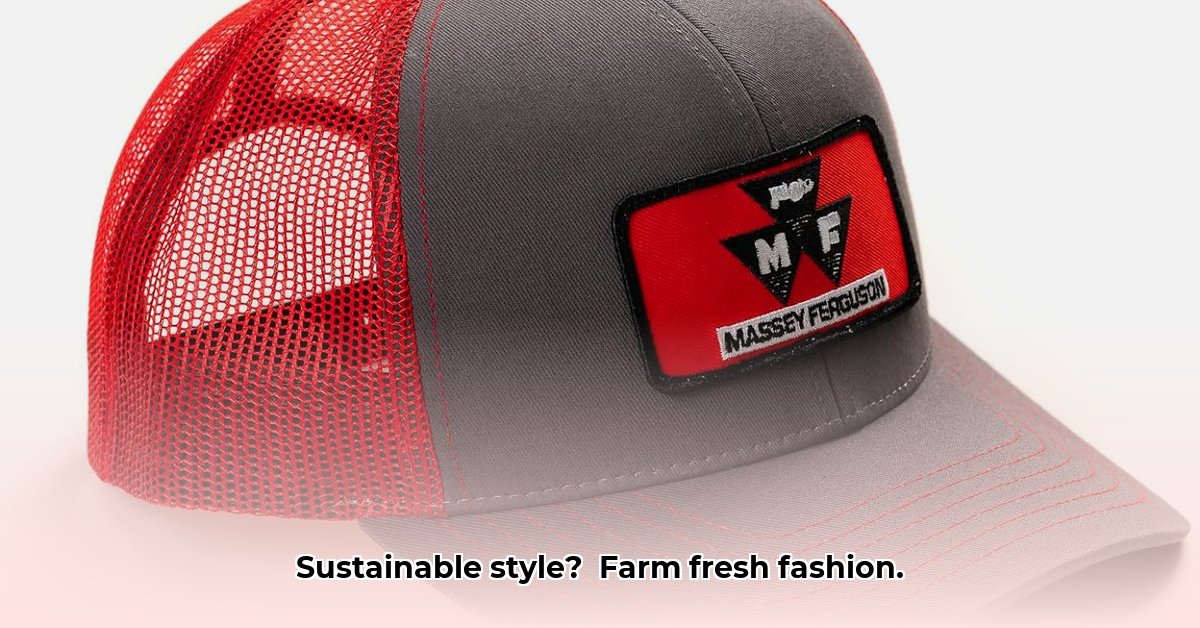
The Enduring Appeal of the Tractor Hat
The image of a farmer, weathered face shaded by a trusty tractor hat, is iconic. This headwear isn't just a nostalgic symbol; it's evolving into a significant element within sustainable agriculture. This article explores how conscious choices in tractor hats—from material selection to design—can contribute to a greener future, benefiting farmers, consumers, and the environment. We will examine the role of sustainable materials, explore design innovations that promote efficiency and safety, and outline actionable steps for making informed purchasing decisions.
Sustainable Materials: A New Era for Tractor Hats
Traditionally, tractor hats were made from wool or cotton. While durable, conventional cotton farming's heavy reliance on pesticides and water raises environmental concerns. However, the industry is shifting towards sustainability. Organic cotton, utilizing less water and eliminating harmful pesticides, presents a superior alternative. Recycled materials, often derived from repurposed plastic bottles or textile waste, offer another impactful choice. Innovative brands are even venturing into plant-based materials like hemp or bamboo, known for their durability and sustainable cultivation. Choosing a sustainably produced tractor hat directly supports environmentally friendly practices and encourages the wider adoption of sustainable manufacturing techniques.
More Than Just Shade: Design and Sustainability
A well-designed tractor hat goes beyond sun protection; it contributes to sustainable farming practices. A wide brim offers superior sun protection, reducing the need for additional sunscreens. Durable construction increases longevity, minimizing waste from frequent replacements. Smart designs may incorporate features enhancing safety and efficiency on the farm, such as improved visibility elements which can reduce accidents and increase productivity. Investing in a high-quality, long-lasting hat directly reduces your environmental footprint and promotes safer farming practices.
The Tractor Hat Community: A Shared Commitment
Within farming communities, the tractor hat transcends mere headwear, especially among those dedicated to sustainable practices. It's often a visual representation of dedication to the land and responsible farming. Wearing a sustainable tractor hat can be a way for farmers to signal their environmental commitment to peers and consumers, fostering discussion and collaboration around sustainable practices within the agricultural sector.
Your Guide to Choosing a Sustainable Tractor Hat
Choosing a sustainable tractor hat involves simple yet impactful steps:
Prioritize Sustainable Materials: Opt for organic cotton, recycled materials, hemp, or other responsibly sourced fabrics. Research the material’s environmental impact and production processes.
Look for Certifications: Seek certifications such as GOTS (Global Organic Textile Standard) or Fair Trade, which ensure ethical and sustainable production practices.
Read Reviews and Research Brands: Analyze customer reviews for insights into a brand's quality, durability, and commitment to sustainability. Research the brand's environmental and labor policies.
Support Ethical Businesses: Choose brands transparent about their supply chains and committed to fair labor practices.
Invest in Durability: A high-quality, durable hat minimizes the need for replacements, reducing textile waste and your overall environmental impact.
The Bigger Picture: Your Choice Makes a Difference
Consumer choices significantly influence market trends. Selecting sustainable tractor hats encourages brands to adopt eco-friendly practices, demonstrating a commitment to a more sustainable future for agriculture and the planet. Even seemingly small choices accumulate to make a significant difference.
How to Calculate the Long-Term ROI of Sustainable Farming Practices (and How Tractor Hat Choices Fit In)
Sustainable farming practices present long-term financial and environmental benefits. While the initial investment may seem high, the long-term rewards, including reduced input costs, enhanced soil health, access to premium markets, and environmental benefits, far outweigh the costs. This improved efficiency and sustainability even translates into a safer working environment for farmers, reducing downtime and fostering a more productive and profitable enterprise—all of which can be enhanced by the thoughtful selection of a durable, sustainable tractor hat that minimizes the need for frequent replacements.
Factors to Consider in Your ROI Calculation:
Reduced Input Costs: Sustainable practices often lower expenses on fertilizers, pesticides, and water.
Enhanced Soil Health: Healthier soil results in higher yields and improved product quality.
Premium Market Access: Consumers increasingly prefer sustainably produced food.
Environmental Benefits: Reduced carbon footprint and improved water quality.
Social Impacts: Support for local communities and job creation.
Careful financial modeling, considering both financial and non-financial benefits, is crucial for assessing long-term ROI. This holistic approach, when extended to choices as seemingly small as a farmer's hat, contributes to the overall sustainability and profitability of farming operations. The long-term benefits of even small choices like sustainable tractor hats contribute to the cumulative positive impact on the farm's sustainability and profitability.
Conclusion: Sustainable Style, Sustainable Future
The seemingly simple tractor hat offers a unique lens through which to view the broader journey towards sustainable agriculture. Choosing a sustainably produced and responsibly designed tractor hat isn’t just about personal style; it’s about supporting ethical practices, promoting environmental stewardship, and contributing to the long-term health of the farming community and the planet. By making informed choices, we collectively shape a more sustainable future.